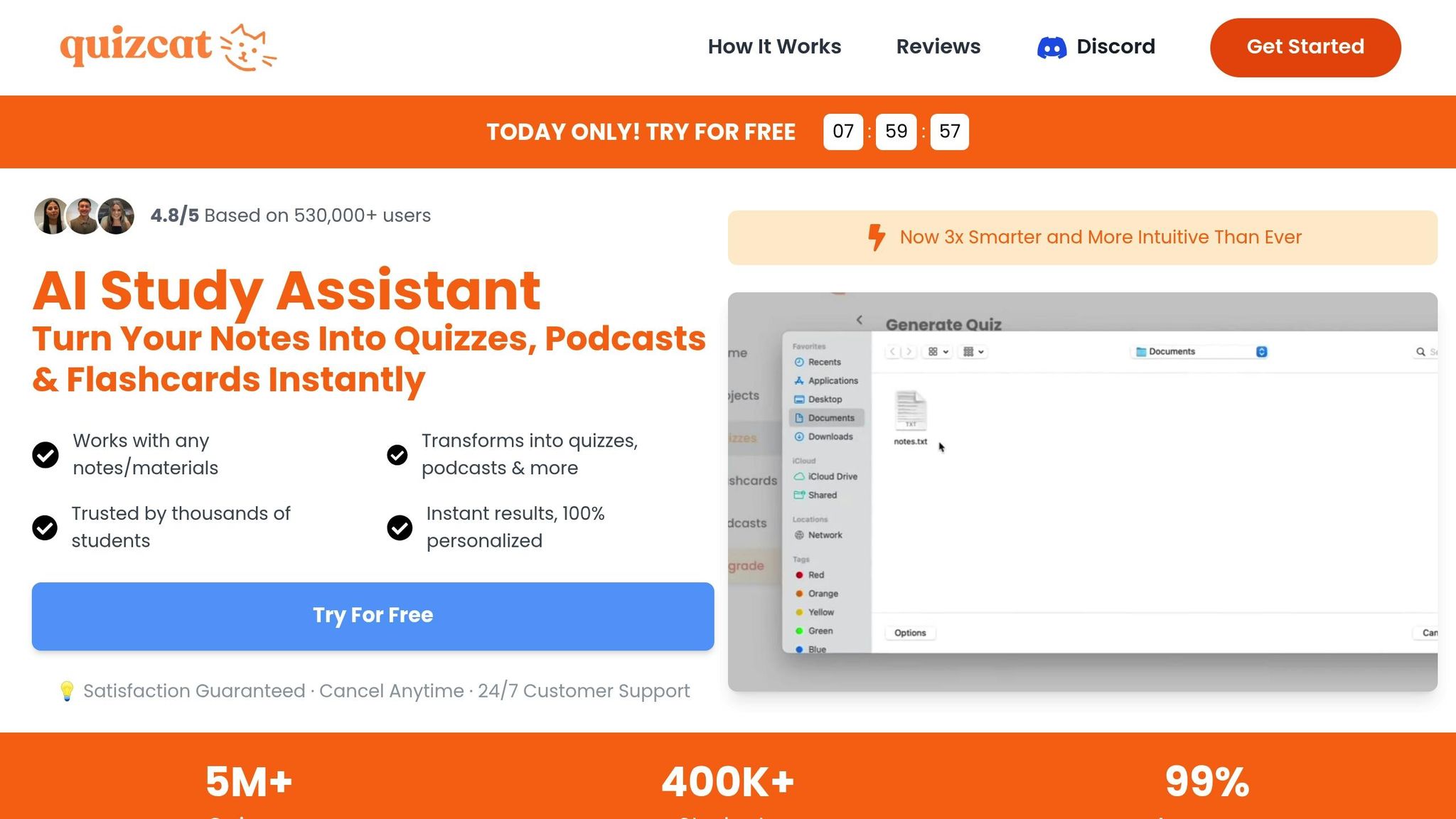
How Predictive Models Shape Personalized Learning
Predictive models are changing how students learn by making education more personalized and effective. Here's what you need to know:
- What They Do: Predictive models analyze student data (like test scores and attendance) to identify learning patterns and predict outcomes.
- Why It Matters: Schools using these tools report a 25% improvement in student outcomes and a 30% increase in test scores.
- Key Benefits:
- Early identification of struggling students.
- Customized learning paths based on behavior and preferences.
- Real-time adjustments to content for better engagement.
- AI Tools in Action: Platforms like QuizCat AI create tailored resources (quizzes, flashcards, podcasts) to fill knowledge gaps, saving students time and boosting performance.
These systems are helping schools reduce dropout rates by 30% and improve attendance by 12%, proving their potential to reshape education.
What’s Exciting About AI's Predictive Power and Personalized Learning?
Key Predictive Modeling Methods in Education
Using various analytical tools, educators can craft a more personalized and effective learning experience that aligns with students' behavior, learning gaps, and individual preferences.
Student Behavior Analysis
Predictive models play a pivotal role in understanding student behavior to create tailored learning paths. These models track important metrics like time spent on tasks, assignment completion habits, quiz scores, and participation in discussions.
Some key behavioral metrics include:
- Time spent on tasks
- Patterns in completing assignments
- Trends in quiz and test scores
- Frequency of interaction with learning resources
- Engagement in group activities
By closely monitoring these factors, educators can quickly identify students who might need extra support. These insights not only help in early intervention but also form the basis for understanding specific learning challenges.
Knowledge Gap Detection
Once behavioral data is gathered, predictive models can zero in on the areas where students are struggling. Advanced algorithms analyze assessment results and learning interactions to highlight specific concepts or skills requiring extra attention. For example, if a student repeatedly underperforms in a particular topic, the system can suggest targeted remedial materials to address those challenges.
Learning Style Analysis
Beyond behavior and knowledge gaps, predictive systems also adapt to each student's preferred way of learning. By analyzing various data points, these systems can identify the most effective methods for individual students. They consider factors such as:
- Preferred content formats (videos, text, interactive tools)
- Study habits and session timing
- Performance on different types of questions
- Usage patterns of learning resources
- Variations in learning speed
Interestingly, students who typically fall in the lowest performance group have shown remarkable improvements, growing 1.5 times faster when supported by these adaptive systems compared to traditional classroom methods.
Predictive Models in Action
By leveraging behavioral patterns, gap analyses, and learning styles, predictive models are now shaping direct classroom interventions. These tools customize learning experiences and help educators step in at the right time to support students.
Smart Content Suggestions
Modern predictive systems analyze student interactions in real time, delivering learning materials that meet students exactly where they are. Schools using these systems have reported impressive results, with student performance improving by up to 25%.
The best smart content systems offer multiple features:
- Real-time difficulty adjustment: Content adapts in seconds based on student responses and performance data.
- Knowledge mapping: These systems highlight connections between concepts to address learning gaps.
- Performance tracking: Platforms monitor metrics like completion rates, time spent on tasks, and assessment results.
For instance, if a student struggles repeatedly with a specific math concept, the system provides additional resources and alternative explanations. This ensures students stay engaged by presenting challenges that are achievable without being overwhelming.
Early Warning Systems
Predictive analytics have revolutionized how schools identify and assist students who are at risk of falling behind. These systems track key indicators such as:
- Attendance patterns
- Assignment completion
- Grade trends
- Engagement levels
- Use of learning resources
Schools using these tools have seen dropout rates drop by 30%. What makes these systems so effective is their ability to flag potential issues early, enabling educators to provide support before traditional assessments would detect problems.
Beyond early alerts, these systems pave the way for tailored interventions, which can further enhance learning outcomes.
Personalized Study Resources
QuizCat AI is a standout example of how predictive models are reshaping personalized learning. By analyzing uploaded study materials through natural language processing, the platform creates customized resources that address specific needs. Over 400,000 students have already benefited from its adaptive learning tools.
QuizCat AI generates interactive quizzes, adaptive flashcards, and even study podcasts to target knowledge gaps. A great example of its impact comes from July 2024, when college student Olivia Brooks improved her exam scores by 15% after using QuizCat AI's podcast feature. By listening to her converted notes during commutes, she saved about 5 hours each week - showing how predictive tools not only improve learning outcomes but also make studying more efficient.
sbb-itb-1e479da
Ethics and Implementation Challenges
As predictive models become more common in education, schools and universities face pressing questions about privacy, fairness, and transparency. Addressing these issues means focusing on protecting student data, reducing bias, and clearly communicating with students about how these systems work.
Student Data Protection
Safeguarding student information is critical when using predictive analytics. Educational institutions must comply with laws like FERPA and ensure data is handled responsibly. Key practices include:
- Encrypting data during storage and transmission to prevent unauthorized access.
- Conducting regular security audits to identify and fix vulnerabilities.
- Restricting access to sensitive data, ensuring only authorized personnel can view it.
- Minimizing data collection, gathering only what is absolutely necessary.
- Establishing strong governance policies to oversee how data is used and managed.
Reducing Model Bias
Predictive models can unintentionally reinforce inequalities, especially if they reflect biases in the data they’re trained on. To address this, institutions should:
- Use diverse training datasets that include representation from all student groups.
- Perform routine bias checks to identify and correct any unfair patterns.
- Experiment with different modeling techniques to reduce reliance on a single approach.
- Involve a diverse team of experts in reviewing outcomes to ensure fairness.
Clear Communication with Students
When students understand how predictive systems work, their engagement can increase significantly - by as much as 75%, according to research. Building trust and fostering transparency requires:
- Breaking down technical language so students can easily grasp how the system operates.
- Keeping students informed about updates and how these changes might impact them.
- Providing tools for feedback and allowing students to adjust their learning preferences.
The Next Steps in Predictive Learning
Main Advantages of Predictive Models
Predictive models are transforming education by delivering measurable improvements. For example, they've been shown to reduce early dropouts by 30%, improve attendance by 12%, and boost standardized test scores by 30%. Perhaps most strikingly, student engagement has jumped from 30% to 75% in some cases. These impressive gains come from analyzing student behavior and performance data, as discussed earlier.
New Developments in Learning Tech
Recent advancements in AI, particularly in natural language processing and real-time data analysis, have made educational predictions sharper than ever. A study by the Gates Foundation found that 80% of teachers using adaptive learning tools reported notable improvements in student performance. These breakthroughs allow platforms to offer highly personalized learning experiences, a great example being QuizCat AI.
QuizCat AI's Learning Solutions

QuizCat AI takes full advantage of these technological developments to improve how students learn. By analyzing individual study materials and progress, the platform generates customized resources like quizzes and study guides tailored to each learner's needs. With a growing community of over 400,000 users and more than 5 million quizzes created, QuizCat AI shows how scalable and impactful AI-driven education can be.
Users have shared glowing reviews of the platform:
"I was drowning in notes before I found this tool. Now, it turns everything into flashcards, quizzes, and even podcasts! Studying has never been this easy. 🚀 Highly recommend!" – Emily Carter
FAQs
How do predictive models help identify and address students' learning gaps?
Predictive models analyze student data to uncover learning patterns, identify strengths, and highlight areas where they might face challenges. By examining factors such as quiz results, time spent on tasks, and engagement levels, these models can zero in on specific knowledge gaps.
Once those gaps are identified, tailored learning strategies come into play. For instance, students might get customized quizzes, specially designed study materials, or suggestions to revisit critical concepts. Tools like QuizCat AI simplify this process by turning study resources into interactive, adaptive tools. This approach helps students concentrate on areas needing improvement while streamlining their overall learning journey.
How do predictive models ensure student data privacy and security?
While the article doesn't delve into the specifics of privacy and security measures for student data in predictive modeling, safeguarding such data generally requires a combination of strong encryption, stringent access controls, and adherence to privacy laws like the Family Educational Rights and Privacy Act (FERPA) in the United States. To explore this topic further, consult resources dedicated to data security in educational technology.
How do predictive models create personalized learning experiences to boost student engagement and success?
Predictive models rely on advanced data analysis to interpret and forecast student behaviors, preferences, and learning patterns. By examining elements such as study habits, quiz results, and topic understanding, these models can suggest customized learning paths that cater to each student's unique needs.
Take QuizCat AI, for instance. This tool uses predictive modeling to turn your notes into interactive resources like quizzes and flashcards. These resources zero in on the areas where you need the most help, keeping you engaged and improving your outcomes. Whether you're gearing up for an exam or diving into a new subject, predictive models make the learning process more focused and tailored to you.
